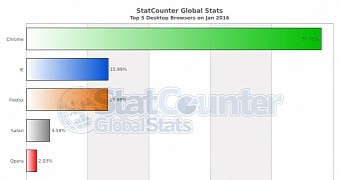Microsoft launched Edge to replace Internet Explorer and fight the negative perception that impacted its adoption for so long, but it appears that the new browser is still struggling to compete against renowned apps such as Google Chrome and Mozilla Firefox.
New figures provided by StatCounter for the month of January 2016 show that Google Chrome continues to lead the charts in the browser world with a share of 57.75 percent, followed by Internet Explorer with 15.99 percent. Firefox is very close behind with 15.98 percent while Safari and Opera are next with 4.59 and 2.03 percent, respectively.
‘So where’s Edge?’ you could ask. Unfortunately for Microsoft and users who actually like Edge browser, the new application is not quite a popular choice for Windows users, but its share is clearly impacted by the limited availability too. Right now, Edge only exists on Windows 10, and Microsoft has no plans to release it on a different platform.
Microsoft Edge 13 (the version available in Windows 10 build 1511/November Update) currently has a share of 1.24 percent while Edge 12 (the original RTM 10240 version) is now at 0.57 percent. This brings Edge browser to 1.81 percent, according to StatCounter data.
Major improvements on their way
Microsoft is well aware of the fact that, for the moment, Edge browser cannot be a full-time replacement for browsers such as Google Chrome and Mozilla Firefox, but the company is very keen on changing that in future updates, such as Redstone.
Extension support is undoubtedly one of the most requested features for Edge browser (alongside the ad blocker, but we all know that’s not going to be implemented by Microsoft), and the company is expected to introduce it with the Redstone update.
Certainly, Edge can only get better with extension support, but unless Redmond rolls out significant features, Chrome and Firefox continue to be much better choices.

 14 DAY TRIAL //
14 DAY TRIAL //